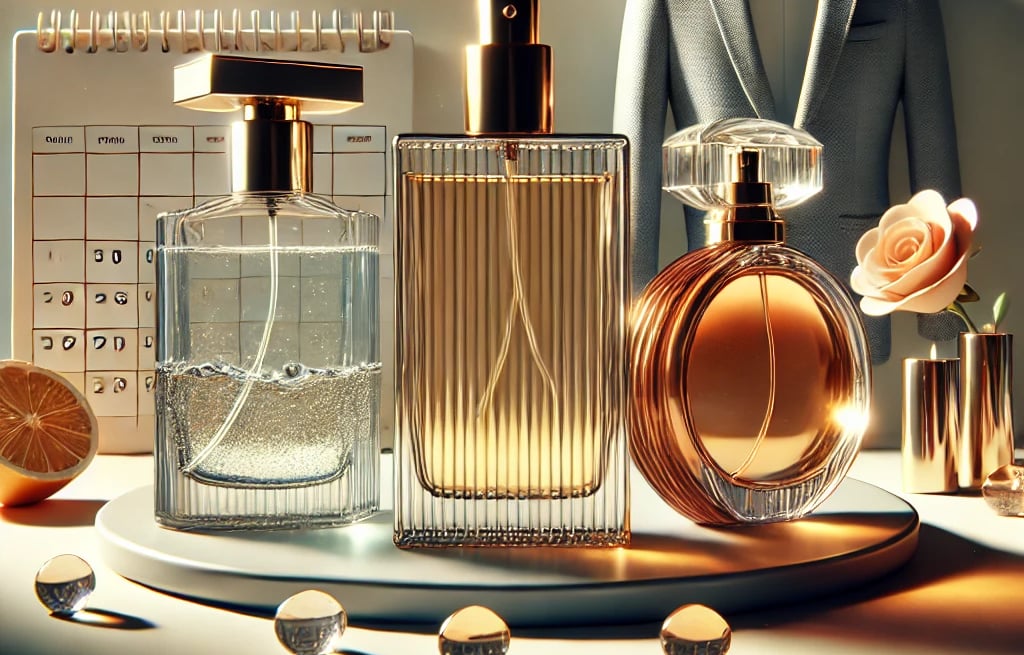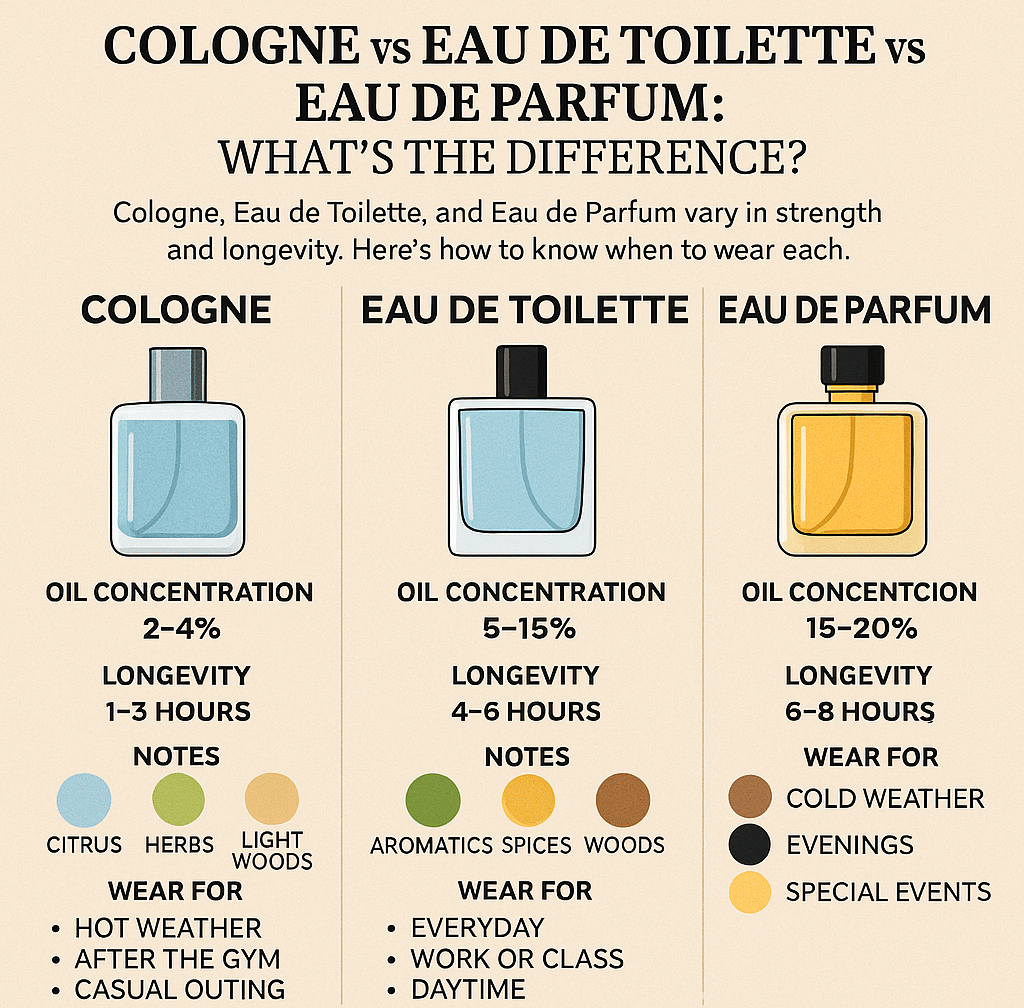Cologne vs Eau de Toilette vs Eau de Parfum: What’s the Difference?
Cologne vs Eau de Toilette vs Eau de Parfum: What’s the Difference? Discover how these fragrance types vary in strength, longevity, and when to wear each for the perfect impression.
7/18/2025


Cologne vs Eau de Toilette vs Eau de Parfum: What’s the Difference?
Cologne vs Eau de Toilette vs Eau de Parfum: What’s the Difference? Discover how these fragrance types vary in strength, longevity, and when to wear each for the perfect impression.
Introduction: Why Knowing the Difference Matters
Buying a new fragrance can feel overwhelming with all the labels—Cologne, Eau de Toilette (EDT), and Eau de Parfum (EDP). What do they actually mean? And how do you choose the right one?
Understanding fragrance concentrations can help you:
Pick a scent that suits your lifestyle and occasion
Avoid overpaying for the wrong formula
Get the best value and performance from your cologne
Let’s break down the difference so you can make smart, stylish fragrance choices.
What Do Fragrance Concentrations Mean?
The Role of Essential Oils and Alcohol
Fragrances are made up of essential oils, alcohol, and sometimes water. The percentage of essential oils determines how strong and long-lasting a fragrance is.
Higher oil concentration = stronger and longer-lasting scent
Lower concentration = lighter, more subtle, shorter-lasting
Fragrance Pyramid: Top, Middle, and Base Notes
Every scent has three stages:
Top notes: First impression, evaporate quickly (citrus, light herbs)
Middle notes: Heart of the fragrance (florals, spices)
Base notes: Deepest layer that lingers (woods, musk, vanilla)
The concentration affects how long each phase lasts on your skin.
Cologne (Eau de Cologne): Light and Refreshing
Typical Composition and Strength
Concentration: 2%–5% essential oils
Longevity: 1–3 hours
Sillage: Light; sticks close to the skin
Cologne is often used to describe any men’s fragrance, but technically, it’s the lightest concentration.
Best Times to Wear Cologne
Hot, humid weather
After the gym or shower
Quick errands or casual outings
Pros and Cons of Eau de Cologne
Pros:
Very refreshing and subtle
Great for layering or quick use
Cons:
Doesn’t last long
May require frequent reapplication
Eau de Toilette: Everyday Versatility
Scent Profile and Popular Uses
Concentration: 5%–15% essential oils
Longevity: 4–6 hours
Sillage: Moderate
EDT strikes a perfect balance between freshness and impact—ideal for daily wear.
Longevity and Projection
EDT lasts through most of the workday and offers enough projection to be noticed without overwhelming others.
When to Choose an EDT Over Other Types
Office or school settings
Daytime events
Spring and summer wear
First-time fragrance buyers
Eau de Parfum: Stronger, Longer, Bolder
Key Ingredients and Strength
Concentration: 15%–20% essential oils
Longevity: 6–10+ hours
Sillage: Stronger and more noticeable
EDPs tend to be richer, deeper, and evolve more noticeably over time.
Ideal Scenarios for EDP Use
Romantic evenings or dates
Formal occasions
Fall and winter seasons
When you want to stand out or make an impression
Pros and Cons of Eau de Parfum
Pros:
Long-lasting
Stronger scent development
Cons:
Can be too intense for warm weather
Often pricier than EDT or Cologne
Comparative Chart: Cologne vs EDT vs EDP
FeatureEau de CologneEau de ToiletteEau de ParfumOil Concentration2%–5%5%–15%15%–20%Longevity1–3 hours4–6 hours6–10+ hoursSillageLightModerateStrongBest ForFreshen-ups, summerDaily wearEvenings, formalPrice Range$$$$$$
How to Choose the Right One for You
Occasion-Based Guide
Work or class? Go with an EDT for freshness without being overpowering.
Gym or daytime errands? A cologne keeps it light and breezy.
Dates, weddings, or evening events? Reach for an EDP to impress and last.
Climate and Seasonal Considerations
Warm climates: Cologne or EDT are more comfortable and breathable.
Cool climates: EDPs project better and hold up in heavier fabrics.
Fragrance Layering with Cologne, EDT, and EDP
Using Matching Products for Longer Scent Life
Use the same scent family in:
Body wash
Deodorant
Lotion
This amplifies your cologne’s effect and helps it last longer.
Layering Light and Deep Notes Strategically
Try:
Spritzing a Cologne or EDT as a base
Adding an EDP of the same family later in the day for added depth
Common Myths About Fragrance Concentrations
Price Doesn’t Always Reflect Performance
A higher-priced EDP might last longer, but some well-formulated EDTs outperform cheap EDPs.
More Oil Isn’t Always Better
Sometimes, a lighter cologne is more appropriate than a heavy EDP—especially in professional or warm environments.
FAQs About Cologne, Eau de Toilette, and Eau de Parfum
Q1. Can I wear EDP daily?
Yes, but go lighter on the sprays—especially in warm or close-contact settings.
Q2. Is EDT better than cologne?
It depends. EDT lasts longer and projects more, but cologne is ideal for short wear or sensitive noses.
Q3. Should I own all three types?
Absolutely. Variety lets you match your scent to your day, just like your clothes.
Q4. Is there a difference in ingredients?
The ingredients can be similar; the difference lies in their concentration.
Q5. How many sprays should I apply?
Cologne: 3–4 sprays
EDT: 2–3 sprays
EDP: 1–2 sprays, depending on strength
Conclusion: Smell Smarter and Choose with Confidence
The difference between Cologne, Eau de Toilette, and Eau de Parfum isn’t just about strength—it’s about purpose, personality, and occasion. When you understand how each works, you can build a fragrance wardrobe that’s as dynamic as you are.
So whether you’re freshening up after a workout or stepping out for a date night, you’ll know exactly what to wear—and why.

